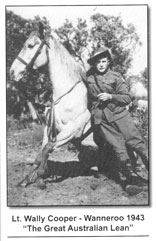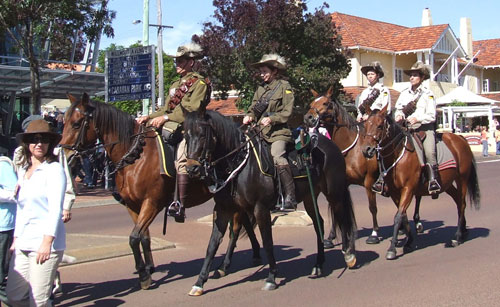Horses arrived in Australia with the First Fleet in 1788. They were picked up in Cape Town, South Africa, together with other livestock and supplies needed for the new Colony. In the years to follow, horses arrived on many of the ships coming to the colony of New South Wales as the importance horses were going to have in the development of this remote and vast continent became apparent.
Horses thrived on the native grasses and out on the open range, surpassing all expectations. From those very early days, breeding good horses became a priority for the Government as well as for a number of the free settlers. Draft and coaching breeds were introduced along with good riding horses and ponies. A number of marines and free settlers took up the challenge to be involved in horse breeding on the large tracts of land offered by the Government. Because of the expense involved in shipping horses to the colony, plus the long sea voyage involved, only the strongest, best quality horses were chosen and only the best of those survived to arrive safely in their new home.
Some of the breeds brought in to Australia originally included; Thoroughbred, Arab, Suffolk Punch, Clydesdale, Shire, Cleveland Bay, Welsh Cob, Coaching breeds, Hackney, Percheron, Timor Pony and a number of the British native ponies. Horse owners began mixing many of the breeds in an attempt to come up with a strong versatile horse that could fill the bill as a short and long distance riding horse, cart horse, coach horse and to be put into the plough when needed. A wonderful uniquely Australian horse evolved - a horse capable of fulfilling all these roles, soon to be sought around the country and subsequently in many other parts of the world.
Because horse breeding was widely successful it was soon realized there was a ready market available with the British army in India, who were always in need of remounts for their Calvary and for private use. The first shipment of Australian horses left Sydney Cove in 1816 for private sale to a British family in India. This trade of horses to private owners continued until around the mid 1830's when the British army noted that these horses had the attributes they also needed for remounts; strong bone, athleticism, courage, intelligence, versatility, excellent temperament, a good riding horse. The lucrative remount trade to India had begun.
A Legend Is Born
From the 1840's onwards, so many thousands of horses were leaving Australia from the state of New South Wales, that the horses became known as "Walers". (Although horses were also shipped out from other ports around the country.) This nickname was due to personnel shortening the name of the port of embarkation on the manifests, because "New South Wales" took such a long time to write down!
The four types of remount horses sought from Australia included:
- Artillery horse - heavy type with more draft influence used for pulling the gun carriage and carrying ammunition;
- Officer's horse - light type with more Thoroughbred influence;
- Trooper's horse - stocky type, versatile, strong and fast with some draft influence used for carrying a Trooper and his equipment, often weighing upwards of 130kg; and
- Scout horse - agile pony type used for relaying messages, polo and sporting.



Light Waler (Officer's Horse) Medium Waler (Trooper's Horse) Heavy Waler (Artillery Horse)
____________________________________________________________________________________
 Pony Type Waler (Scout Horse)
Pony Type Waler (Scout Horse)
________________________________________________
Many of the local princes in India began to seek them for their own private armies, also as sporting and carriage horses. By the 1860's they were known as the finest Cavalry horses in the world with their courage and stamina unsurpassed.
 In 1898 when the Boer War broke out Australia was ready to send men and horses to fight for Queen and country. These colonials as mounted infantry were known as a wild undisciplined lot who could ride and shoot with exceptional skill. The horses were often treated badly as they were put into battle as soon as they arrived on South African shores, instead of giving them the opportunity to acclimatize and have sufficient rest after a gruelling sea voyage. Despite this the horses and their Australian bushman army did themselves proud as they could work alone or work as a team with uncanny navigational skills.
In 1898 when the Boer War broke out Australia was ready to send men and horses to fight for Queen and country. These colonials as mounted infantry were known as a wild undisciplined lot who could ride and shoot with exceptional skill. The horses were often treated badly as they were put into battle as soon as they arrived on South African shores, instead of giving them the opportunity to acclimatize and have sufficient rest after a gruelling sea voyage. Despite this the horses and their Australian bushman army did themselves proud as they could work alone or work as a team with uncanny navigational skills.
During the time of the "Great War" 1914-18, once again Australia's finest men and horses were to prove themselves in the desert sands of Northern Africa against the German and Turkish war machine, this time as the Australian Light Horse. Together with their New Zealand counter-parts they formed a mounted Infantry Brigade which became known as the famous "Desert Column" - a fighting force legendary for its courage and horsemanship.
Poems, books and feature films have all been made and written about these men and their wonderful Waler horses. None greater than the last great cavalry charge in history when the Australian Light Horse, after riding through the hot desert sand for two days and a night, and desperate for water, were given the order by Lieutenant-General Chauvel to take the wells of Beersheba. To do that, they had to charge over an open plain of three miles (5km) against the Turkish cannons, machine guns and the German bombs being dropped from overhead planes.
Against all odds these brave men and horses secured the wells, and over 100,000 allied men and horses quenched their thirst that night. This is the legend of Beersheba.
At the end of the war when we were celebrating our victory and there was much jubilation the order was given that the horses would not be returning to Australian shores. The reasons being the expense was too great to bring them home, plus our now strict quarantine restrictions. This decision proved extremely distressing to the men who had come to know their beloved horses as mates, who had fought the war together and relied on one another. There were 12,000 Waler horses left at the end of WWI, just a small percentage of the approximately 160,000 that had left Australian shores. The soldiers, heart broken at the thought of leaving their horses behind on foreign shores to a life of hardship in Egypt, defied orders and quietly shot their horses. A number of horses uninjured and still in good health were bought by the Indian army and returned to India, some were purchased by the British army and British Officers and taken back to the British Isles.
Between the First and Second World Wars the Light horse continued as Militia units around the country. In WWII some units of soldiers and remount horses were conscripted to transport ammunition to ships for our armed forces overseas. Also North Australia Observer Unit, known as the "Nackeroos" or "Curtin's Cowboys", a secret army of men and horses were mobilized across our Northern coast line as a reconnaissance troop keeping watch for possible landing from the enemy. They worked in two's and three's often out for months on end. These men and their horses had a dangerous lonely mission to fulfil.
Our Walers also went with our soldiers to carry supplies in New Guinea as well Java and Borneo. Their part in WWII is neither widely known nor acknowledged. During WWII there was a plan that if the Japanese Army ever came to Australia from our northern shores the Brisbane line was to take effect and the Light Horse mobilized to take on the enemy in our great outback. This did not happen and the remount horses were let loose often on crown land, in particular in northern New South Wales and Queensland.
There are those who say there are no Walers as only one is known to have returned after WWI. However the fact is that there were still 900 horses waiting to leave our shores when peace was declared in 1918, plus the breeding stock that bred those horses. They were still on the many breeding properties around the country. There is some evidence to suggest that the remount trade continued between Australia and India up until the mid 1960's.
By the end of WW11, due to mechanisation horses were no longer work horses except in the outback, in the cities they were ridden for pleasure, sporting and show horses, on the whole people wanted to have the new horses coming into the country, the more showy breeds. In the 1960's and 1970's, the new lines available from the Thoroughbred, Arabian, Quarter Horse, and the many American and European horse breeds now became popular and readily available. The Waler, the "plain" Australian bush horse or utility horse, once lauded as the finest cavalry horse in the world, were forgotten as having "had their day". Not so!
For info on the Modern Day Waler see this fact sheet - 'The Modern Day Waler' by 'The Waler Horse Society of Australia'




